Are you a Quiet Speculation member?
If not, now is a perfect time to join up! Our powerful tools, breaking-news analysis, and exclusive Discord channel will make sure you stay up to date and ahead of the curve.
At last, War of the Spark is fully spoiled! From a design perspective, I think War bodes well for Modern's future, and more specifically for the upcoming Modern Horizons. And the set itself has some juicy cards, too. While David's review sought to quell the excitement surrounding some perhaps-not-excellent War cards, this article goes over the expansion's cards I think are most likely to see Modern play, covering both its flexible format additions and promising new planeswalkers.
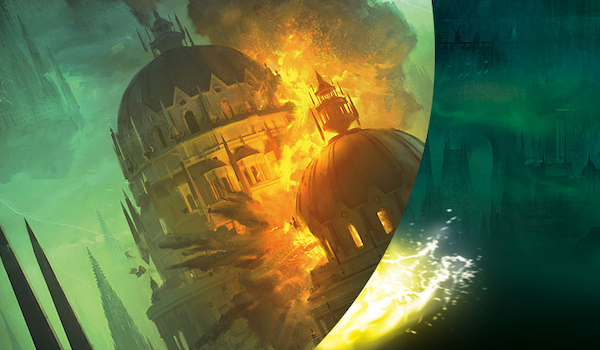
Bend It Back
Some of War's standout cards employ a tried-and-true way to enter Modern: with flexibility. This is the kind of card that has me most excited about Wizards's current design direction. If Horizons is indeed full of cards designed in this way, but deemed a little too strong for Standard, the set is bound to have some serious ramifications.
There are plenty of cards that go the other way, of course—Price of Betrayal, The Elderspell, and Dovin's Veto are all undercosted for their potential ceiling, but extremely narrow. In this section, we'll look at the cards with wider applications that are still aggressively-costed enough for Modern.
Liliana's Triumph
 Liliana's Triumph was one of the first cards spoiled from War, and got the ball rolling with a bullet; I'd heard players perk up at the idea of a Diabolic Edict reprint in Horizons, and here was a strictly better version: non-targeting and with some upside! While Triumph will be cast as plan-old Edict most of the time, its synergy with Liliana planeswalkers gives an additional buff to 8Rack and BGx. Being able to throw out Triumph during the opponent's draw step can essentially deny them a turn, much like Kolaghan's Command sometimes does.
Liliana's Triumph was one of the first cards spoiled from War, and got the ball rolling with a bullet; I'd heard players perk up at the idea of a Diabolic Edict reprint in Horizons, and here was a strictly better version: non-targeting and with some upside! While Triumph will be cast as plan-old Edict most of the time, its synergy with Liliana planeswalkers gives an additional buff to 8Rack and BGx. Being able to throw out Triumph during the opponent's draw step can essentially deny them a turn, much like Kolaghan's Command sometimes does.
BG Rock is the most obvious home for Triumph, as it's the only one of the two aforementioned decks that actually puts up results. But that deck is already packed with role-players and often splits its removal slots meticulously. I doubt Triumph stabilizes as more than a one- or two-of there, but expect to occasionally run into it.
Angarth's Rampage
Angarth's Rampage, too, fits into Rock-style decks, if forcing a red splash—Jund and Mardu can run it, anyway. And so can the Rakdos Stompy deck I covered a couple weeks ago, which can't hate having more removal options that get around its own Chalice of the Voids. That's a deck that I can see actually fitting Rampage despite the card's relevant lameness, as it badly craves ways to answer planeswalkers that resolve over lock pieces (and requires some amount of creature removal anyway).
Lazotep Plating
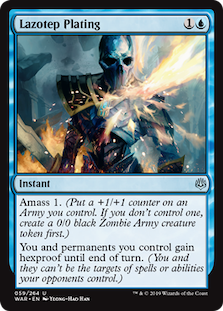 This card is more my speed, or at least my colors. Lazotep Plating might look a bit one-dimensional on the surface, but I think it does a surprising amount for its cost. In protect-the-queen-style decks like Delver, Plating helps beat attrition opponents by stopping removal spells (even the now-powercrept Abrupt Decay) while insulating against Liliana of the Veil. But while Blossoming Defense, with its power/toughness boost, has seen some play in Infect, Mizzium Skin and its kin haven't been so fortunate. So what sets Plating aside from the other protection spells?
This card is more my speed, or at least my colors. Lazotep Plating might look a bit one-dimensional on the surface, but I think it does a surprising amount for its cost. In protect-the-queen-style decks like Delver, Plating helps beat attrition opponents by stopping removal spells (even the now-powercrept Abrupt Decay) while insulating against Liliana of the Veil. But while Blossoming Defense, with its power/toughness boost, has seen some play in Infect, Mizzium Skin and its kin haven't been so fortunate. So what sets Plating aside from the other protection spells?
For starters, Plating doesn't just protect threats. It gives "permanents you control" hexproof, letting it protect lands from Ghost Quarter, artifacts from Abrade, or planeswalkers from Maelstrom Pulse. And it stops multi-targeting spells like Electrolyze or Kolaghan's Command.
The card also has a second mode: it gives its caster hexproof. In other words, even with no creatures in play, the instant counters burn to the face, Liliana of the Veil's downticks, and the edict effects outlined above, all while making a body. I think this card has just enough going on to occasionally show up in sideboards across a range of archetypes.
Narset's Reversal
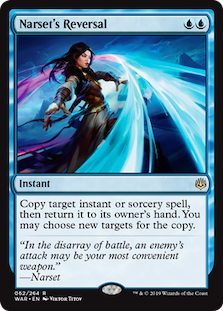 Narset's Reversal reminds me of Remand. Its UU cost is more prohibitive, but it offers players a higher ceiling, if a less stable effect. Instead of drawing a card, pilots get to copy an opponent's spell after returning it to the hand, which can range from useless to excellent. A major drawback of Reversal compared with Remand: Reversal can only hit instants and sorceries, while Remand can bounce creatures, planeswalkers, you name it. That makes the new instant's uses more limited than the former's by default, but it still has its big moments.
Narset's Reversal reminds me of Remand. Its UU cost is more prohibitive, but it offers players a higher ceiling, if a less stable effect. Instead of drawing a card, pilots get to copy an opponent's spell after returning it to the hand, which can range from useless to excellent. A major drawback of Reversal compared with Remand: Reversal can only hit instants and sorceries, while Remand can bounce creatures, planeswalkers, you name it. That makes the new instant's uses more limited than the former's by default, but it still has its big moments.
In a creature mirror, bouncing a removal spell and pointing the copy at an opponent's threat provides a huge tempo swing. Multi-mode spells also offer a lot of versatility. The best spells to target, though, are ones with additional costs. For cards like Collective Brutality, the escalate has already been paid, so opponents will have to discard again to get the same effect next time. But we still benefit from the improved copy. Or imagine casting Reversal on an opponent's Lightning Axe—not only does our creature live to swing another day, but opponents hemorrhage resources and even lose that Thing in the Ice in the process!
 Remand was also used in its heyday to counter a pilot's own spells, generally in response to countermagic. Reversal can be used for the same purpose. Here, instead of drawing a mystery card, pilots get their spell back for another go-round—probably an upgrade if they want to copy it in the first place.
Remand was also used in its heyday to counter a pilot's own spells, generally in response to countermagic. Reversal can be used for the same purpose. Here, instead of drawing a mystery card, pilots get their spell back for another go-round—probably an upgrade if they want to copy it in the first place.
One more aspect to consider is that Reversal doesn't "counter" spells, it just bounces them. That gives it the same odd utility as Venser, Shaper Savant and Unsubstantiate in that it temporarily deals with uncounterable spells such as Supreme Verdict or Dovin's Veto.
With all that being said, though, I think Reversal's high-ceiling cases will prove rare enough to mostly keep this card out of Modern. It could still show up as a one-of in control and tempo decks, as weird role-players tend to occupy those slots.
Return to Nature
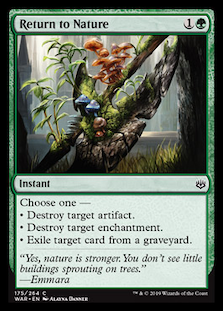 I've long praised Destructive Revelry in Modern, and have included it in many of my Delver decks. Even in Ancient Grudge colors, that 2 damage adds up when you're swinging, and can be worth giving up the flashback. There's also the added utility of hitting enchantments to consider.
I've long praised Destructive Revelry in Modern, and have included it in many of my Delver decks. Even in Ancient Grudge colors, that 2 damage adds up when you're swinging, and can be worth giving up the flashback. There's also the added utility of hitting enchantments to consider.
Return to Nature gives up that 2 damage, but adds even more utility: it hits cards in the graveyard. I can think of plenty of instances in this iteration of Modern where I'd rather have the functionality of Coffin Purge than 2 damage on my Naturalize. Against Arclight Phoenix, for instance. Or Dredge! Not that Return is a great sideboard option against Phoenix decks (although it does hit Pyromancer's Ascension), or that there aren't better cards to run for Dredge. But Return does provide a little extra incidental hate for graveyard decks if it's in the sideboard.
Return also seems good at nabbing random Snapcaster targets. The card might come in for those matchups to hit pesky enchantments (Runed Halo) or artifacts (Batterskull), but boasts additional roles when those cards aren't around.
Blast Zone
Engineered Explosives on a colorless land? Now that's flexibility! I've heard two statements over and over when it comes to evaluating this card:
- Blast Zone is powerful enough that many decks will tweak their manabase to accommodate it.
- Colorless Eldrazi Stompy wants four copies.
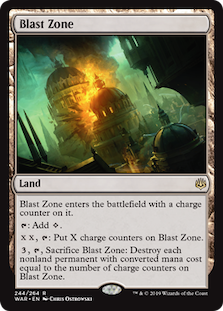 I disagree with both, and on the same basis: Modern is too fast for this card to fulfill its intended purpose with any kind of frequency. The color-light decks that could fit Blast Zone will probably have something better to play a lot of the time, like Field of Ruin or manlands; I do see Zone making a splash in colorless big mana decks, though, such as Tron.
I disagree with both, and on the same basis: Modern is too fast for this card to fulfill its intended purpose with any kind of frequency. The color-light decks that could fit Blast Zone will probably have something better to play a lot of the time, like Field of Ruin or manlands; I do see Zone making a splash in colorless big mana decks, though, such as Tron.
As for Colorless Eldrazi, the card is certainly a shoe-in there; here's yet another mainboard answer to those pesky Ensnaring Bridges, not to mention an anti-aggro tool. Heck, it even removes Stony Silence, a card that otherwise neuters our grinding plan against white decks! But four copies is far too many. We'll draw multiples in excess when having a split of utility lands would have helped win us the game. I'm starting with two copies, and have made room for a 24th land to accommodate both Karn and Zone. Since last week's article, I've cut a Gemstone and an Endless One for the Zones, and swapped the sideboard Torpor Orb for that second Gut Shot (unrelated, but maybe useful).
Parsing the Planeswalkers
War of the Spark is chock-full of planeswalkers, and I think some of them will find their way into Modern. David has expressed disappointment at the design of these walkers, essentially boiling them down to "attackable enchantments." But not all decks attack or house reach, so in many cases, players will be getting a walker (or, enchantment-plus-ability) on the cheap.
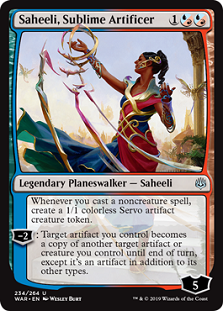 My strategic beef with the walkers is a different one: they seem to lack cohesion. Not cohesion from a flavor standpoint necessarily, but in terms of abilities, the walkers tend to have effects that don't interact with one another. I think that can keep them from seeing widespread play, as nobody wants to overpay for just half of a card when the other half is functionally dead. Take Saheeli, Sublime Artificer. This card seems fit for decks that chain together noncreature spells, but it's a full mana more expensive than Young Pyromancer, and for what? It's harder to remove? The second ability is just not so relevant in those decks, making this actually just an attackable enchantment with some extra text.
My strategic beef with the walkers is a different one: they seem to lack cohesion. Not cohesion from a flavor standpoint necessarily, but in terms of abilities, the walkers tend to have effects that don't interact with one another. I think that can keep them from seeing widespread play, as nobody wants to overpay for just half of a card when the other half is functionally dead. Take Saheeli, Sublime Artificer. This card seems fit for decks that chain together noncreature spells, but it's a full mana more expensive than Young Pyromancer, and for what? It's harder to remove? The second ability is just not so relevant in those decks, making this actually just an attackable enchantment with some extra text.
The upside to this predicament is that when both halves are good, the walker in question ends up being great. In this section, we'll look at the walkers that might pull off that balance by breaking down their static abilities, their plusses/minuses, and their possible homes.
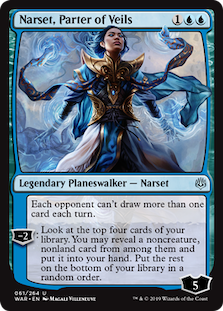 Narset, Parter of Veils
Narset, Parter of Veils
Static: Hoses cantripping decks like Izzet Phoenix, Hollow One, and maybe even Tron.
Minus: Finds answers to stuff, or perhaps a combo.
Homes: Turning off Faithless Looting is big game in Modern right now, but at three mana, this effect leaves much to be desired. As a sideboard card against draw-heavy decks, Narset might be a little slow at that price point. I think it has a better shot in the mainboard of an answer-based deck that likes to tap out, like UW Midrange.
 Ashiok, Dream Render
Ashiok, Dream Render
Static: Hoses searching, most notably fetchlands. Doesn't prevent opponents from searching for our own Field of Ruins, though.
Minus: Mills either player and nukes the opponent's graveyard.
Homes: Ashiok disrupts on two levels by stopping searches and graveyard interactions. That makes it better against more decks, but not especially good against one deck, as most graveyard decks are light on searching and vice versa; here we again have the problem of these walkers being pulled in many directions at once. The "mill 4" is only really a gameplan in, well, Mill. Still, I can see self-mill proving useful to power up creatures like Pteramander or assemble a value/combo engine.
Domri, Anarch of Bolas
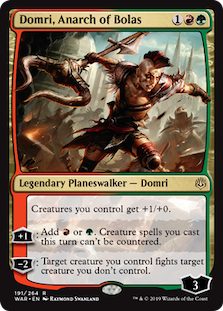 Static: An anthem. Useful for winning Goyf wars or just getting opponents dead. Always live in aggro decks.
Static: An anthem. Useful for winning Goyf wars or just getting opponents dead. Always live in aggro decks.
Plus: As a rare walker, Domri has a plus ability, too. This one generates mana, which is pretty much always useful, and comes with a can't-be-countered clause—niche, but nice.
Minus: In a deck with large creatures, can act as heavy-duty removal for larger threats.
Homes: I'm eager to try Domri in GRx Moon, a deck I've now been shopping for almost four years. My latest build featured Sarkhan, Fireblood as another way to ditch extra pieces and lands, a strategy Domri supports by producing mana. When using Domri's minus, Tarmogoyf wins every Tarmo-fight thanks to the anthem.
Teferi, Time Raveler
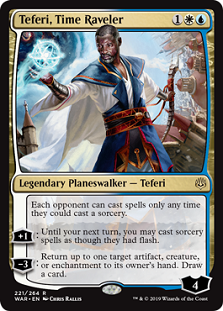 Static: Limits when opponents can cast spells. Only relevant against decks with instants (half of them?).
Static: Limits when opponents can cast spells. Only relevant against decks with instants (half of them?).
Plus: Will need to be played in a deck that can benefit from this effect to be worthwhile at all.
Minus: A very useful bounce ability for decks that can struggle with certain permanents, including hosers and creatures. The cantrip at the very least lets Teferi replace itself and start gradually ticking up to another bounce at no cost in cards.
Homes: I agree with David that Teferi is quite narrow, and probably at strategic odds with UW Control. But I think the walker could have a home in some sort of UWx aggro-control shell where its plus enables instant-speed Serum Visions. These decks like to hold up their mana anyway, and Teferi makes their choices easier. The bounce also gives them random game against stuff that could otherwise lock them out.
Karn, the Great Creator
 Static: Stony Silence is already a great reason to be splashing white in Modern, so it's no secret how great this static is against the right deck. It is, however, useless against a large portion of the field.
Static: Stony Silence is already a great reason to be splashing white in Modern, so it's no secret how great this static is against the right deck. It is, however, useless against a large portion of the field.
Plus: Can mostly just be used in specific decks that have artifacts they'd like to swing with. Also turns enemy artifact lands and 0-drops into 0/0s, which kills them, but I don't think this effect is very relevant, as tho decks are already hosed significantly by the static effect.
Minus: The real draw to Karn, this ability lets players dig out any artifact from their sideboard.
Homes: Despite being a colorless Stony, most decks won't want Karn; it's just too much mana to pay for the effect. Those that do are the ones that already have sideboards full of juicy targets. The walker seems like a great fit in Colorless Eldrazi Stompy, as elaborated on here, as well as for Gx Tron. The latter would already work up to 10 mana for Ulamog, and Karn asks the same amount before assembling the Mycosynth Lattice combo that prevents opponents from tapping their lands for mana—the cost can even be split. Ulamog is still better under pressure, as it creates a big blocker and removes two permanents right away. But on an empty board, Karn will seal the deal, as well as offering utility throughout the game with its minus.
Winning the War
There are no losers during spoiler season. Which cards do you think show the most promise? Let me know in the comments!




Hey there,
I think you’re missing a major component of Narset’s Reversal, which is hitting your own spells. nothing on the card says they have to be opponent’s spells.
Imagine hitting your own counterspells in a counterwar, redirecting the copy to the original target, getting the counter back and fizzling opponents counterspell. Gets around Dovin’s Veto too.
or imagine casting larger value spells (cryptic, kolaghan’s command, your own removal, even wraths etc), then holding priority, bouncing your own spell while copying it. it basically works like a Snapcaster Mage for spells in your hand.
The big downside compared to Remand is its limitation to instants and sorceries, which i think denies it any maindeck slots in blue control decks. But it could potentially be a very very good sideboard card for UWx, Grixis, UR decks etc.
Interested what you think about this!
Check the section again, I actually covered this!
I think Narsett’s reversal will work for mill decks. That deck wants a maximum number of mill spells, and there are few mill spells that are actually good. This card acts similar to mission briefing in that it can maximize the best mill spells for cheap. That archive trap just got cast twice for the low cost of UU and its STILL in the graveyard for mission briefing later in the game. That’s the only realistic mainboard deck I can see wanting 4 copies of this spell.
The idea of Mill as Archive Trap.dec gels well with Modern’s status as a format boasting increasingly streamlined decks! Would love to see this succeed.
I don’t think Narset’s Reversal really does anything against Supreme Verdict. Sure, you bounced it, but you also had to copy it, so unless you have like, a niv magus elemental, it’s still happening.
Ooh you’re right, that “may” is in the wrong place. Well, that’s some utility gone…
Thoughts on the new Ugin?
Seems like a possible sideboard card in Eldrazi – if we’re already interested in getting to six, a card that helps us to grind while also taking out opposing problem cards (like a flier racing us or a teferi or a deaths shadow) seems like a nice flexible package.
But the corner cases are where it gets very sweet:
The fact that any scourges it flips are instantly castable for 1 mana (while keeping your spirit), and the fact it makes the lattice / karn combo ONLY COST 6 instead of 10 (meaning you can drop it and lock your opponent out instantly, as they are unlikely to be able to kill a 6 loyalty Ugin with a free blocker) mean I’m excited to give it a try.
Karn combo cost
Also it is nice that blast zone comes down and murders Noble Hierarch and Champion of the Parish / glistener elf / slippery Bogle instantly, so there are probably local metagames where it deserves a third copy.
It seems closer to Engineered Explosives than Ratchet Bomb – getting to the relevant 1-3 range sooner, but with greater mana investment.
Idk about a 3rd copy still, the price is just hella steep for Stompy. But that’s what I meant by “anti-aggro applications.”
Ah gotcha, I thought you viewed it more as a general answer.
Do you like Ugin? As above, I think he might earn a slot in my 75.
No, way to expensive. Lattice is not a plan that will come out most of the time; just something decks like UW need to have on their radar against us that lets us punish reactive decks for not dealing with the walker. Having a 6-drop in the deck would never work.
I even tried 2 sideboard Wurmcoil Engine in some events while Jund Shadow was blowing up; resolving the Wurm was an instant-win against that deck. But with Powders and Simian Guides still in the deck, 6 proved too steep, and I was forced to cut it. Most Modern decks are also able to apply pressure like Jund Shadow can. But conversely, Resolving Ugin does not instant-win against any deck.
tldr: Eye of Ugin is a great effect at 0 mana. It’s not playable at 6.
What; Not even an Eye that comes with Grizzly bears and Vindicate stapled on?
Thanks for the info, I always wondered what happened when you tried Wurmcoil, they seem so busted in some matches but I never got around to testing it myself.